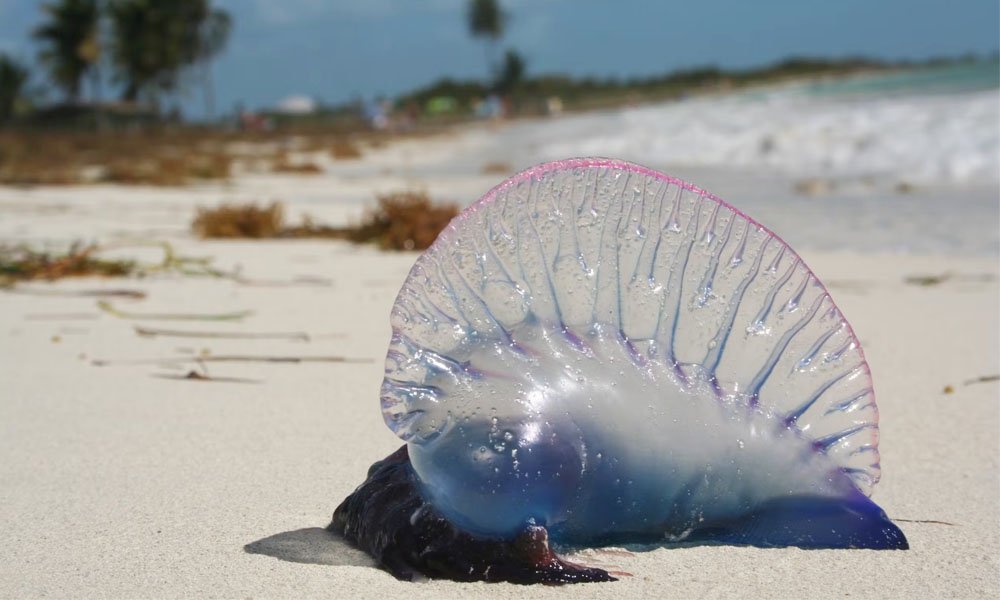News
Jellyfish Warning Flags Tenerife Beach: What Tourists Must Know
Published
3 months agoon
By
Alexander
Imagine you’re on holiday in Tenerife, ready to enjoy the warm sun and splash in the sea. But when you arrive at the beach, you see yellow and purple flags waving in the wind. What do they mean?
Many people don’t know this, but these flags are important safety signs. They tell you when it’s safe to swim—and when jellyfish or other marine creatures might be nearby.
In this article, we’ll explain everything you need to know about the jellyfish warning flags in the Tenerife beach system. You’ll learn what each flag means, what to do if you see them, how to stay safe, and what’s really going on under the water.
Let’s dive in!
What Are Jellyfish Warning Flags?
Jellyfish warning flags are simple, colorful flags used to show beach safety conditions. In Tenerife and many other places in Spain, lifeguards raise these flags to help protect swimmers from possible danger in the sea.
These flags are not just random colors—they each have a clear meaning. If a flag is raised, it means the water might not be safe for swimming. Lifeguards check the sea every day and raise the right flag to keep people informed.
Flags can warn about big waves, strong currents, or marine animals like jellyfish. Knowing what each flag means is a simple way to keep your beach day fun and safe.
Yellow and Purple Flags
The yellow flag is one of the most common. It tells swimmers to be careful. This could be because of waves, currents, or even jellyfish near the shore. You can still swim, but you need to stay alert and follow any advice from lifeguards.
The purple flag is a bit more special. It means there are dangerous sea creatures nearby—usually jellyfish. These flags have recently been raised on Tenerife beaches, especially because of sightings of the Portuguese Man O’ War, which can be very painful if it stings you.
When you see both a yellow and a purple flag flying together, it means there is a serious need to be careful. You may want to skip swimming altogether or at least stay very close to the shore and follow all warnings.
Jellyfish Warning Flags at Tenerife Beach: Latest Update
Recently, Las Teresitas Beach in Santa Cruz de Tenerife became the center of attention. Lifeguards raised yellow and purple flags after multiple jellyfish were seen along the shoreline. The sea looked beautiful, but the danger was floating just below the surface.
The jellyfish found there included the Portuguese Man O’ War. Because of this, the Red Cross sent boat patrols to keep an eye on the water and protect swimmers. They checked if more jellyfish were nearby and made sure people were staying safe.
Tourists were surprised to learn that even on a calm, sunny day, the sea can hide painful creatures. This is why the flag system is so important—it tells you the truth about what’s happening in the water, even when everything looks perfect.
What Is the Portuguese Man O’ War?
The Portuguese Man O’ War is often called a jellyfish, but it’s not a true jellyfish. It’s actually something called a siphonophore—a group of small creatures that work together as one. Still, most people just call it a jellyfish because it looks and stings like one.
This sea creature is easy to spot. It has a balloon-like float that can be blue, violet, or pink, and it sits just above the water. But the real danger is under the surface. It has long tentacles, which can be as long as 10 meters (about 33 feet)!
These tentacles are full of tiny stingers that can cause serious pain. Even if the jellyfish looks small or is washed up on the beach, it can still sting you. That’s why you should never touch one, even if it looks harmless or dead.
Why the Sting Is So Dangerous
Getting stung by a Portuguese Man O’ War is no joke. The sting is very painful and can cause a sharp burning feeling, like touching fire. Some people also get muscle spasms, red welts, or feel dizzy afterward.
In rare cases, the sting can lead to serious problems like trouble breathing or heart issues, especially if someone is allergic or very sensitive. Even healthy adults can have a strong reaction to the venom.
The worst part? These creatures don’t always float close to the shore. Sometimes, the wind and ocean currents carry them into swimming areas quickly. That’s why it’s so important to pay attention to jellyfish warning flags Tenerife beach lifeguards raise—they help you stay one step ahead.
Should You Swim When Jellyfish Flags Are Up?
If you see a yellow and purple flag together, it’s best to avoid swimming that day. You might think, “I’ll just stay in the shallow water,” but jellyfish can float or drift anywhere, and it’s not worth the risk.
Some people still swim, but they stay very close to the beach and watch the water carefully. If you choose to go in, make sure you don’t go too far, and always listen to lifeguards.
Lifeguards are trained to spot danger before it gets worse. If they say to leave the water, do it right away. It’s better to miss a quick swim than deal with the pain of a jellyfish sting.
What Tourists Must Know Before Entering the Water
If you’re on a beach in Tenerife and see jellyfish warning flags, don’t ignore them. These flags are not just for show. They are there to keep you and your family safe.
Before you go into the sea, take a moment to check the flag pole near the lifeguard station. If you see a yellow or purple flag, ask the lifeguard if it’s safe to swim. They usually speak some English and are happy to help.
Also, never touch jellyfish—not even the ones washed up on the sand. They may look dead, but their tentacles can still sting. Kids are often curious, so keep an eye on them when walking near the shoreline.
What to Do If You Get Stung by a Jellyfish
Even with all the warnings, accidents can happen. If you get stung, don’t panic. But also, don’t rub the area. That only makes things worse by spreading the venom.
Here’s what to do:
-
Rinse the area gently with saltwater—not fresh water.
-
Apply a cold pack (like ice wrapped in cloth) to reduce swelling and pain.
-
Use a cream with antihistamine or cortisone if the sting looks red and itchy.
-
Go to a doctor or hospital if the pain doesn’t go away, or if you feel dizzy, weak, or short of breath.
The jellyfish warning flags Tenerife beach system is there to help avoid these situations. But if a sting does happen, quick action makes all the difference.
Why Jellyfish Are Appearing More in Tenerife
You might wonder why this is happening now. Why are there more jellyfish near Tenerife beaches in 2025 than before?
Experts say it’s mostly because of rising sea temperatures. Warmer water helps jellyfish grow and spread faster. Also, pollution and fewer sea turtles (which eat jellyfish) mean jellyfish have fewer natural enemies.
Sometimes, ocean winds and currents carry jellyfish from the Atlantic Ocean to places like the Canary Islands. That’s why species like the Portuguese Man O’ War—which usually live far away—are showing up on local beaches like Las Teresitas.
So, the jellyfish warning flags in Tenerife are not just random events—they are signs of a real and growing change in the ocean.
Other Tenerife Beaches Affected by Jellyfish Flags
Las Teresitas isn’t the only beach facing this problem. Other beaches in Tenerife have also raised jellyfish warning flags in recent years.
For example:
-
La Pinta Beach in Costa Adeje raised purple and white flags due to jellyfish.
-
In La Gomera (a nearby island), a young child was stung in 2023, which led to temporary beach closures.
-
Jellyfish were also spotted on the southern coast of Spain, in places like Malaga, Marbella, and Tarifa.
This shows that jellyfish sightings are increasing, and more beaches are taking action with early flag warnings.
How to Spot Jellyfish in the Water or on the Sand
It helps to know what jellyfish look like, so you can stay away from them. The Portuguese Man O’ War has a soft, balloon-like float that can be pink, blue, or violet. It often looks like a bubble just above the water.
But the tentacles underneath are long and dangerous. Sometimes, you might not even see the tentacles, but they can still reach far out in the water.
On the sand, jellyfish might look dry or harmless, but they can still sting you. So, if you see something shiny or strange near your feet, back away. Teach kids to never poke or play with beach creatures.
Final Safety Tips for Tourists in Tenerife
Here are some easy and helpful tips to stay safe on Tenerife beaches:
-
Always check the flags before swimming.
-
If you see yellow or purple flags, stay alert or skip swimming for the day.
-
Listen to lifeguards—they know what’s going on in the sea.
-
Don’t touch jellyfish, even if they look dead.
-
Learn the meanings of red, yellow, purple, green, and blue flags.
-
Use online beach apps or news sites for real-time flag alerts in Tenerife.
A simple flag can tell you a lot. So next time you’re enjoying a sunny day on a Tenerife beach, just look up at the flagpole—it might save you from a painful sting.
Final Thoughts
The jellyfish warning flags on the Tenerife beach system are more important than ever. With more jellyfish being seen in the water, tourists need to understand what the flags mean and how to respond.
Tenerife is still a beautiful and safe place to visit. But just like you wear sunscreen to protect your skin, checking the beach flags protects your time in the sea.
So stay safe, stay smart, and enjoy your holiday without any stings!
You may also read, Harry and Meghan News: Royal Feud Now ‘Worse Than Ever’
You may like


How to Plan a 48-Hour Luxury Trip to London

Benefits of Partnering with an Expert Foundry

Choosing the Right Supported Independent Living Option for Your Needs

Why Companies Worldwide Are Hiring Power BI Developers

Experience Pure Android Gameplay with MuMuPlayer Emulator

A Guide To Solar PV For Homeowners

How to Convert a Historic Building into a Hotel: a 2025 Guide

How You Can Integrate AI into Your Small Business For Faster Growth

File Recovery on Android: Myths vs. Facts

Cooler, Safer, Clearer: Why Quality Window Tint Is a Smart Upgrade in 2025

Carol Kirkwood’s Journey: Her Real Age, Husband, Career, and More

Revolutionizing Healthcare: The Emergence of AI-Driven Analytics

How Machine Learning and AI are Redefining the Future?

Aliza Barber: Meet Lance Barber’s Wife, Age, Life, Profile, Career and Net Worth

Evelyn Melendez: Jordan Knight’s Wife Bio, Marriage, Family, Career and Net Worth

Ilan Tobianah Biography: Family, Marriage, Lifestyle, Career and Net Worth

Who was Alice Marrow? Everything to Know About Ice-T’s and His Mother

King Von’s Autopsy Report: The Truth Behind the Tragic Death

Meet Otelia Cox: The Supportive Wife of Tony Cox – A True Fairy Tale Romance

Tea Leoni and Tim Daly Split – A Closer Look at Their Relationship and Breakup

How to Plan a 48-Hour Luxury Trip to London

Benefits of Partnering with an Expert Foundry

Choosing the Right Supported Independent Living Option for Your Needs

Why Companies Worldwide Are Hiring Power BI Developers

Experience Pure Android Gameplay with MuMuPlayer Emulator

A Guide To Solar PV For Homeowners

How to Convert a Historic Building into a Hotel: a 2025 Guide

How You Can Integrate AI into Your Small Business For Faster Growth

File Recovery on Android: Myths vs. Facts

Cooler, Safer, Clearer: Why Quality Window Tint Is a Smart Upgrade in 2025
Category
Trending
-

 News3 months ago
News3 months agoCarol Kirkwood’s Journey: Her Real Age, Husband, Career, and More
-

 Health2 years ago
Health2 years agoRevolutionizing Healthcare: The Emergence of AI-Driven Analytics
-

 Technology2 years ago
Technology2 years agoHow Machine Learning and AI are Redefining the Future?
-

 Celebrity2 years ago
Celebrity2 years agoAliza Barber: Meet Lance Barber’s Wife, Age, Life, Profile, Career and Net Worth
